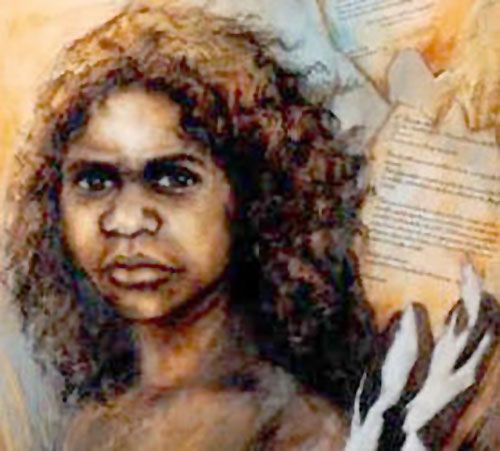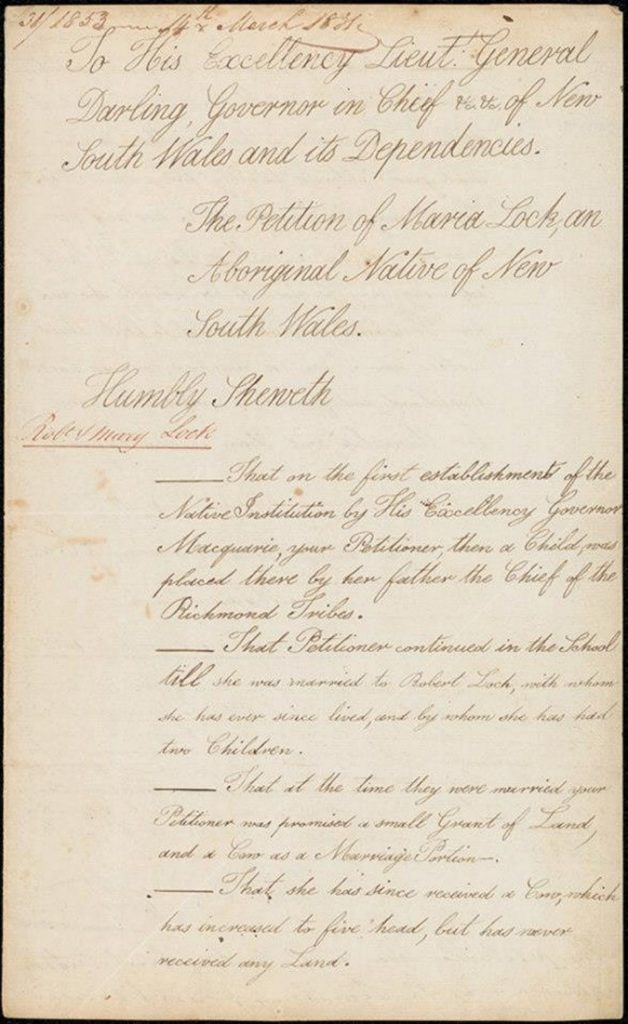
Artist impression of Maria Lock. Maria’s Dilemma and the Darug Legacy, 2009, by Darug artist Leanne Tobin. Courtesy the artist. Photo Adam Hollingworth [3].
Maria, the daughter of Yarramundi ‘Chief of the Richmond Tribes’, belonged to the Boonooberongal clan of the Darug people [1].
Born c.1805, Maria grew up at Richmond Bottoms on the eastern flood plains of the Deerubbin (known today as the Hawkesbury River), close to where the town of Richmond is now located [2].
On 28 December 1814, Maria attended Governor Macquarie’s first meeting with Aboriginal peoples of the Cumberland Plain in Parramatta with her father and clan. On that same day Maria became the first student of the Native Institution. Whilst Maria was voluntarily admitted by her father, the Native Institution soon became the first place where Aboriginal children were institutionalised following involuntarily removal from their families within the colony, marking the first of government policies that led to the Stolen Generations. [4]. Another of the early students at the Native Institution was Kitty.
Name of the Children of the Aborigines secured into the Native Institution Parramatta since it’s foundation, 10 January 1814. Source: Parramatta Sun [5]
Maria remained a student of the Native Institution for several years and in March 1819, outperformed over 100 Aboriginal and non-Aboriginal students in the school anniversary examinations, taking out the major prize [6].
By 1822, Maria was living in the household of the Rev. Thomas Hassall and his wife Anne in Parramatta. In that year Maria married Dicky, son of renowned Bennelong and a member of the Richmond clan through his mother. Dicky became ill and died within weeks of the marriage. On 26 January 1824, Maria married again, to Robert Lock an illiterate convict carpenter working on the construction of the new Native Institution at Black Town. This was the first officially sanctioned Aboriginal-British union within the colony [7].
Maria and Robert settled in Black Town in a rustic timber hut on four acres (1.6 hectares) adjoining the Native Institution, but a year later moved to the Reverend Robert Cartwright’s farm at Liverpool, beside Cabramatta Creek. Over the next twenty years, Maria and Robert had ten children and Maria continued to pursue the land grant she had been promised, but not received, at the time of her marriage [8].
Maria’s petition to Governor Darling following her brother Colebee’s death to receive his land in Black Town. Source: Dictionary of Sydney [9].
Despite several unsuccessful attempts at petitioning various governors, in February 1833 Maria received the first land grant to an Aboriginal woman in the colony, forty acres at Liverpool (along Brickmakers Creek to the current Council Chambers) [10] in the name of Robert Lock:
“in Trust for the said Maria Lock during her life for the sole and separate use without the control of her present or future husband she may have and remain in trust for the Heirs of the said Maria Lock by you her present husband the said Robert Lock begotten.” [11]
Later, in 1843, Maria also received her brother Colebee’s thirty-acre grant and returned to Black Town, acquiring a further thirty-acres the following year [12].
Maria lived until 1878, twenty-four years after Robert passed away. She died in Windsor in her seventies and was buried beside Robert at St Bartholomew’s Church of England, Prospect. Her burial registration read ‘Last of the Aboriginals from Blacktown’ [13].
Nine of Maria and Robert’s children survived into adulthood and Maria’s land in Liverpool and Black Town was divided equally amongst them on her death and occupied by her descendants. However, in what is considered by some to be the ‘second major theft of Aboriginal lands in NSW’ [14] the freehold land was converted to an Aboriginal reserve (Plumpton), and was revoked by the Aborigines Protection Board. Today, dozens of families trace their descent through Maria to Yarramundi and to his father Gomebeeree, an unbroken link stretching back to the 1740s [15]. Jacinta Tobin, one of Maria’s descendants, has previously spoken about her connection to her ancestors and their land:
“The most important thing to me is to give my family a chance to be Darug.” [16].
‘Members of Aboriginal and Torres Strait Islander communities are advised that the this article contains images, names and stories of deceased peoples.’
Chrissie Crispin, Research Assistant – Work placement and Neera Sahni, Research Services Leader, City of Parramatta 2018
References
[1] Parry, N. (2005). Lock, Maria (1805–1878). Australian Dictionary of Biography. National Centre of Biography, Australian National University. Retrieved on 13/06/18 from http://adb.anu.edu.au/biography/lock-maria-13050/text23599
[2] Women’s Resource Centre of Liverpool. (n.d.). Maria Lock. Women of Liverpool. Retrieved on 13/06/18 from http://lwrc.org.au/gallery
[3]Tobin, L. (2009). Maria’s Dilemma and the Darug Legacy. Acrylic on canvas. Retrieved on 14/06/18 from http://www.abc.net.au/radionational/programs/archived/artworks/leanne-tobin/3049602
[4] Watson, V. (2015). Bicentenary event for first ‘Stolen’ children. Parramatta Sun. 9 January 2015. Retrieved on 13/06/18 from http://www.parramattasun.com.au/story/2806910/bicentenary-event-for-first-stolen-children/
[5] Watson, V. (2015). Bicentenary event for first ‘Stolen’ children. Parramatta Sun. 9 January 2015. Retrieved on 13/06/18 from http://www.parramattasun.com.au/story/2806910/bicentenary-event-for-first-stolen-children/
[6] Brook, J. Lock, Maria. (2008). Dictionary of Sydney. Retrieved on 13/06/18 from http://dictionaryofsydney.org/entry/lock_maria
[7] Parry, N. (2005). Lock, Maria (1805–1878). Australian Dictionary of Biography. National Centre of Biography, Australian National University. Retrieved on 13/06/18 from http://adb.anu.edu.au/biography/lock-maria-13050/text23599
[8] Brook, J. Lock, Maria. (2008). Dictionary of Sydney. Retrieved on 13/06/18 from http://dictionaryofsydney.org/entry/lock_maria
[9] Brook, J. Lock, Maria. (2008). Dictionary of Sydney. Retrieved on 13/06/18 from http://dictionaryofsydney.org/entry/lock_maria
[10] Women’s Resource Centre of Liverpool. (n.d.). Maria Lock. Women of Liverpool. Retrieved on 13/06/18 from http://lwrc.org.au/gallery
[11] Watson, J. (1994). Maria Lock – A Remarkable Woman. Western Sydney History. Western Sydney Libraries. Retrieved on 13/06/18 from http://www.westernsydneylibraries.nsw.gov.au/westernsydney/
[12] Parry, N. (2005). Lock, Maria (1805–1878). Australian Dictionary of Biography. National Centre of Biography, Australian National University. Retrieved on 13/06/18 from http://adb.anu.edu.au/biography/lock-maria-13050/text23599
[13] Brook, J. Lock, Maria. (2008). Dictionary of Sydney. Retrieved on 13/06/18 from http://dictionaryofsydney.org/entry/lock_maria
[14] Watson, J. (1994). Maria Lock – A Remarkable Woman. Western Sydney History. Western Sydney Libraries. Retrieved on 13/06/18 from http://www.westernsydneylibraries.nsw.gov.au/westernsydney/
[15] Parry, N. (2005). Lock, Maria (1805–1878). Australian Dictionary of Biography. National Centre of Biography, Australian National University. Retrieved on 13/06/18 from http://adb.anu.edu.au/biography/lock-maria-13050/text23599
[16] Lewis, D. (2006). Darug people’s new dreaming – the return of the land they called home. Sydney Morning Herald. 3 July 2006. p.2. Retrieved on 14/06/18 from https://www.smh.com.au/news/national/darug-peoples-new-dreaming–the-return-of-the-land-they-calledhome/2006/07/02/1151778811749.html?page=2




